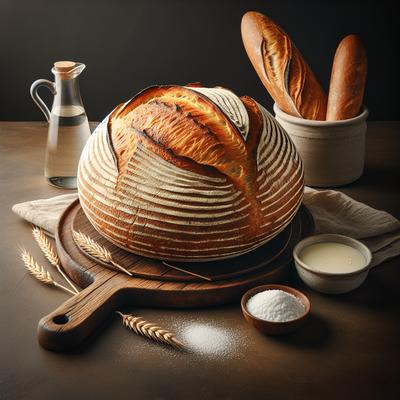Sugar-Free Classic Sourdough Bread
Dive into the timeless art of breadmaking with this Sugar-Free Classic Sourdough Bread recipe, a wholesome, naturally leavened loaf that's as nourishing as it is satisfying. Crafted with just four simple ingredients—active sourdough starter, warm water, bread flour, and salt—this recipe skips added sugars, letting the tangy, complex flavors of fermentation shine. With its chewy crust, airy crumb, and rich aroma, this artisan bread is perfect for breakfast toast, hearty sandwiches, or simply enjoying with a smear of butter. Featuring a cold proofing process for enhanced flavor and a step-by-step guide to mastering stretches and folds, this recipe is ideal for both seasoned sourdough enthusiasts and beginners looking to perfect their craft. Savor the taste of homemade sourdough with a loaf that's as beautiful as it is delicious!
Try SnapCalorie's FREE AI assisted nutrition tracking free in the App store or on Android.

Scan with your phone to download!

Ingredients
- 200 grams Active sourdough starter
- 325 ml Warm water (about 95°F/35°C)
- 500 grams Bread flour
- 10 grams Salt
Directions
Step 1
1. In a large mixing bowl, combine the active sourdough starter and warm water. Stir gently until the starter is mostly dissolved.
Step 2
2. Add the bread flour gradually, mixing with a wooden spoon or your hands until a rough dough forms.
Step 3
3. Cover the bowl with a damp cloth and let the dough rest for 30 minutes for autolysis.
Step 4
4. After resting, sprinkle the salt over the dough. Use your hands to incorporate the salt by pinching it into the dough and folding the dough over itself several times.
Step 5
5. Begin the bulk fermentation: Stretch and fold the dough by pulling up one side of the dough and folding it over the middle. Rotate the bowl and repeat this process 4 more times. Let the dough rest for 30 minutes.
Step 6
6. Repeat the stretching and folding process every 30 minutes for the next 2 hours, for a total of 3 sets of stretches and folds.
Step 7
7. Once the stretching and folding is complete, leave the dough to ferment undisturbed for 2 to 4 hours, until it has risen by about 50% and looks bubbly.
Step 8
8. Lightly flour a work surface and gently turn the dough out onto it. Shape the dough into a ball by folding edges towards the center, then flip it seam-side down.
Step 9
9. Allow the dough to rest for about 20 minutes, uncovered, to relax before the final shaping.
Step 10
10. For the final shape, flip the dough back over and shape it into a tight ball or oval, depending on your proofing basket's shape.
Step 11
11. Place the shaped dough seam-side up in a flour-dusted proofing basket or bowl. Cover and refrigerate for 12 to 24 hours for cold proofing, developing flavor.
Step 12
12. Preheat your oven to 450°F (230°C) with a Dutch oven inside for at least 30 minutes.
Step 13
13. Once preheated, carefully remove the Dutch oven, place a parchment cut-out at the bottom and transfer the dough into it, seam-side down.
Step 14
14. Score the bread with a sharp blade or razor to allow expansion. Cover with the lid and bake for 20 minutes.
Step 15
15. After 20 minutes, remove the lid and reduce the temperature to 425°F (220°C). Bake for an additional 25 minutes until the bread is deeply golden and sounds hollow when tapped.
Step 16
16. Let the bread cool on a wire rack for at least 1 hour before slicing to allow the crumb to set.
Nutrition Facts
| Serving size | (1039.7g) |
|---|
| Amount per serving | % Daily Value* |
|---|---|
| Calories | 1920 |
| Total Fat 8.5g | 0% |
| Saturated Fat 1.7g | 0% |
| Cholesterol 0mg | 0% |
| Sodium 3945.3mg | 0% |
| Total Carbohydrate 400g | 0% |
| Dietary Fiber 15.5g | 0% |
| Total Sugars 1.5g | |
| Protein 62g | 0% |
| Vitamin D 0IU | 0% |
| Calcium 85mg | 0% |
| Iron 23mg | 0% |
| Potassium 540mg | 0% |
Source of Calories
